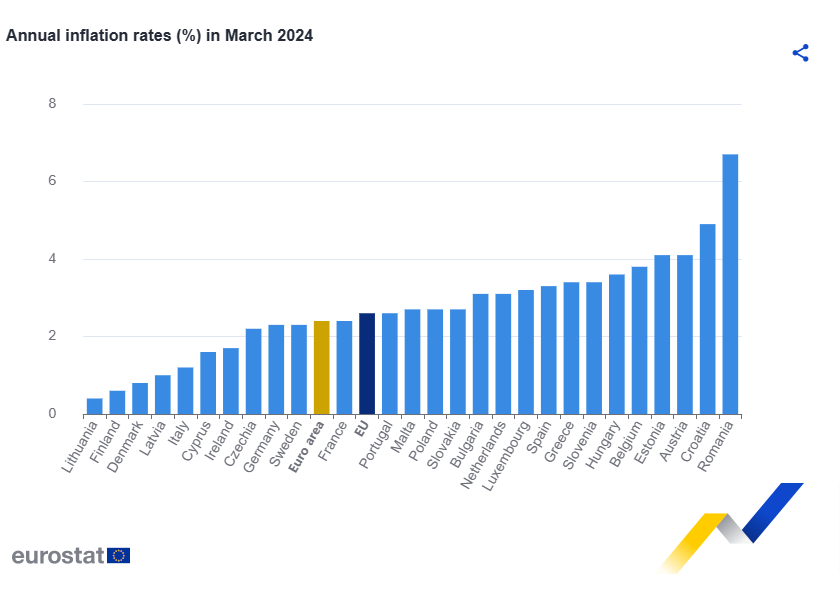V březnu se meziroční míra inflace v zemích eurozóny snížila z únorových 2,6 % na 2,4 %, v Evropské unii z 2,8 % na 2,6 %. Níže je přehled jednotlivých zemí dle Eurostatu. Rozdíly mezi některými zeměmi nejsou malé.

Ze zemí eurozóny mají 4% nebo vyšší míru inflace Chorvatsko (4,9 %), Rakousko a Estonsko (4,1 %). Ze zemí mimo eurozónu tuto úroveň překonává inflace v Rumunsku (6,9 %).
V porovnání s okolními státy má Česká republika nejnižší inflaci. Podle metodiky EU dosahuje březnová inflace v České republice 2,2 %, v Německu byla 2,3 %, na Slovensku a v Polsku 2,7 % a v Rakousku 4,1 %. V často přidávaném Maďarsku dosahuje inflace 3,6 %.
Největším jestřábem z uvedených zemí je Magyar Nemzeti Bank s reálnou úrokovou sazbou 4,9 %. Následuje ČNB s reálnou úrokovou sazbou dle inflace HICP ve výši 3,55 %, Narodowy Bank Polski s reálnou úrokovou sazbou 3,05 %. Reálná úroková sazba v Německu vychází 2,2 %, na Slovensku
1,8 % a v Rakousku pouhých 0,4 %.
……
March inflation rate in the European Union
In March, the yearly inflation rate in the eurozone dropped to 2.4% from 2.6% in February, while in the European Union, it decreased from 2.8% to 2.6%. The following is a detailed breakdown by country as reported by Eurostat. The variations among certain countries are quite significant.

Within the euro area, Croatia, Austria, and Estonia are witnessing inflation rates of 4% or above, with Croatia having the highest rate at 4.9%, Austria and Estonia 4.1%. Meanwhile, among non-euro area countries, Romania stands out with the highest inflation rate, reaching 6.9%.
Compared to its neighboring countries, the Czech Republic boasts the lowest inflation rate. Following the EU methodology, the inflation rate in the Czech Republic for March was 2.2%, marginally lower than Germany’s 2.3%. Slovakia and Poland both reported an inflation rate of 2.7%, while Austria had the highest rate at 4.1%. Hungary, which is often included in these comparisons, experienced an inflation rate of 3.6%.
At the forefront of the nations, Magyar Nemzeti Bank emerges as the most prominent hawk, boasting an impressive real interest rate of 4.9%. Trailing behind is the CNB, with a real interest rate of 3.55% based on HICP inflation, while Narodowy Bank Polski maintains a real interest rate of 3.05%. In comparison, Germany’s real interest rate stands at 2.2%, Slovakia’s at 1.8%, and Austria’s at a mere 0.4%.

